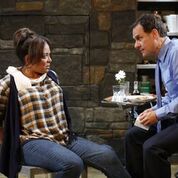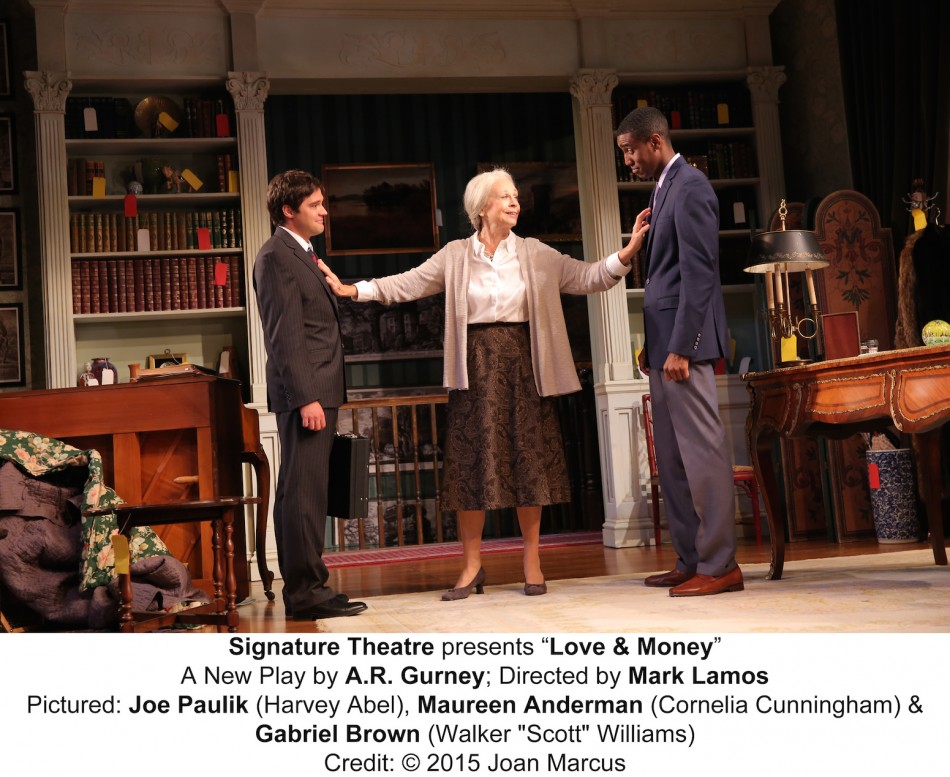By Samuel L. Leiter
The producers of Catch the Butcher, Adam Seidel’s spotty black comedy about a serial killer, at the Cherry Lane, pulled off a clever publicity coup by casting one of its two major roles with Lauren Luna Vélez. Fans of Dexter, TV’s popular dramatic series about a Miami serial killer, will remember her as Capt. Maria Laguerta, the tough, full-bodied, sexy head of homicide. After Capt. Laguerta eventually discovered that Dexter was the Bay Harbor Butcher, she was being prepped for his scalpels only to be dispatched with a bullet by his sister. I don’t know if Seidel was inspired by Dexter, but fans will spot similarities.
In Catch the Butcher (which premiered at California’s Long Beach Playhouse in 2013), Vélez plays Nancy, single and in her mid-forties, who has moved to Texas from Milwaukee and who, very early in the play, is abducted from her park bench by the Butcher of Harbor Park; he’s already chopped up eleven local women and dumped them in the river. This, though, isn’t a whodunit but a work that attempts to explore the Stockholm Syndrome-like relationship that grows between Bill (Jonathan Walker), the neatly-dressed, mid-fortyish killer, and his attractive victim. Nancy’s handcuffed to a chair in Bill’s soundproofed basement bunker, where Bill keeps surgical equipment and a hardware store’s worth of saws, screwdrivers, hammers, and the like. But Nancy, rather than show fear, engages Bill in conversation; he, impatient to get on with his job but being a rather polite fellow, delays his slicing, dicing, pounding, and pulverizing (he even dons a white protective suit, plastic apron, and visored helmet) to answer her queries.
Nancy, who actually put herself in harm’s way to meet him, shows little fear of being cut, pierced, or chopped. (By the way, if you can believe the ease with which she removes her cuffs I have a bridge I’d like to sell you.) Bill, struggling between his growing fascination with this sticky wicket of a victim and his need to finish her off, stabs her in the leg, but, soon after, skillfully tends her wound like the doctor he admits to being. Bill vaguely explains why he kills women, and the affectless Nancy, who’s tried suicide and is seeking an experience that will make her feel something, anything, explains her attraction to Bill. Soon enough, Bill and Nancy start living together as a superficially normal couple; like a retro wife from the 1950s, Nancy cleans, cooks, mixes cocktails, and wears a pretty frock (costumes are by Brooke M. Cohen) to cater to her favorite psychopath when he comes home from work.
But Nancy grows frustrated by Bill’s peculiarities (he refuses her scrambled eggs!) and his insistence that she live a cloistered life—no restaurants, no shopping, and, especially, no neighbors. A neighbor does show up, however, in the person of a colorful Texan homebody named Joanne (Angelina Fiordellisi), and Nancy lets her in, along with all the trouble—including a bit of worm-turning on Nancy’s part—that Bill dreaded all along. When the final moments arrive, whatever vaguely expressed issues have led Bill and Nancy into their ill-fated relationship are resolved in a way I won’t spoil, but that’s essentially as contrived as so much else along the way.
Catch the Butcher, for all its implausibilities, actually might have worked as an offbeat comic thriller had it been buoyed by clever direction, sprightly performances, and a flexible setting, none of which it receives. The pace is funereal, the scene shifts (using illusion-shattering, black-garbed stage hands) are interminable, and the would-be laughs little more than forced titters. Much of this is clearly the fault of director Valentina Fratti, who seems to have been unable to determine the proper tone between quiet naturalism, melodramatic suspense (scary music [by Quentin Chiapetta] and lighting [by Graham Kindred] between scenes), and quirkily chilling comedy in the Alfred Hitchcock vein, excuse me, mold. Walker is woodenly uninteresting as the schizophrenic Bill and Vélez brings intelligence but no comic spark to her victim; only Fiordellisi offers a spirited performance, albeit in a stereotypical role.
Lauren Helpern’s misconceived set employs fieldstone walls for both the living room and basement of Bill’s house, but what’s needed is a stripped-down unit setting that can transform instantaneously without the need for sluggish scene shifts.
Catch the Butcher may be about a serial killer, but that’s no reason for it to be so deadly.
Photos: Carol Rosegg
Catch the Butcher www.cherrylanetheater.org
Cherry Lane Theater
38 Commerce Street, NYC
Through October 30






















